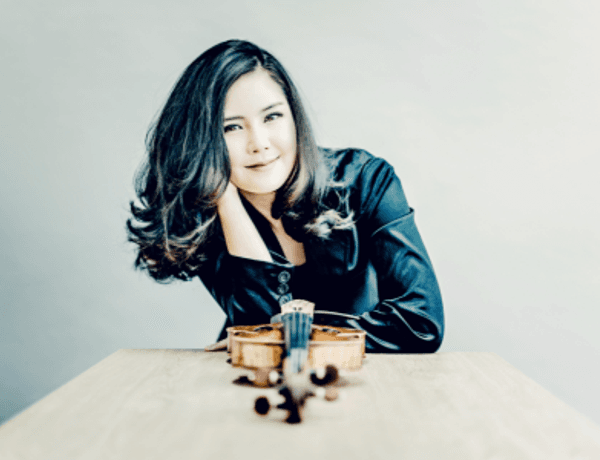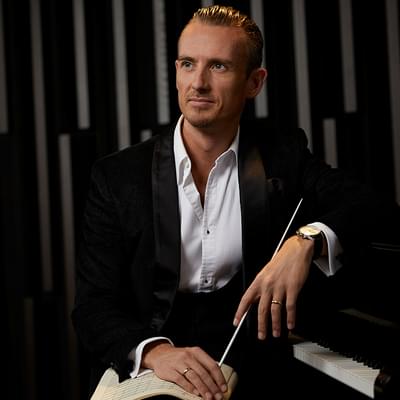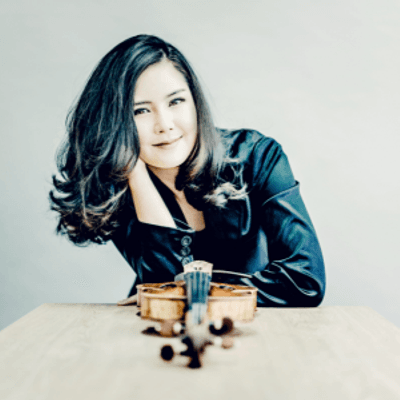Stravinsky's Firebird

Full programme
- Gershwin, An American in Paris (16mins)
- Price, Violin Concerto No.2 (14mins)
- Price, Adoration (4mins)
- Ravel, Le Tombeau de Couperin (17mins)
- Stravinsky, The Firebird (1919) (23mins)
Performers

Alexander Shelley
Conductor
Hyeyoon Park
Violin
Introduction
I’ve been hugely looking forward to my debut with the City of Birmingham Symphony Orchestra and to sharing the stage today with Alexander Shelley for the first time.
This is a glorious programme that contains a number of established masterworks written in the first half of the 20th century - works that have firmly found their place in the repertoire after years of gracing our concert stages. While Florence Price’s Adoration (written 1951) and her Second Violin Concerto (written 1952) almost made it into that first half of the century, they are compositions that were completely unknown until 2009, when they were found in an abandoned house on the edge of an Illinois village. There is something enormously exciting about playing music that has existed for so long and yet is so fresh to our ears, especially when it was nearly lost to history!
Price’s Second Violin Concerto is filled with fantasy, brilliance and beautiful melodies. At only 16 minutes in length, it’s short for a concerto, but so much happens during that time. There’s drama, luscious tunes and high-flying notes by the bow-full. She definitely puts the violinist through their paces! Among all those fast and brilliant passages though, watch out for those unmissable melodies; there’s one that comes back three times throughout the concerto, each time garbed in different tonal colours.
After the concerto I’ll play Price's Adoration, which I think makes for a perfect pairing. A complete contrast to this quicksilver concerto, it is a work that is calming and spiritual in nature. Originally written for the organ, it has the familiar and timeless quality of a hymn. It’s the kind of work that makes you feel like you’ve always known it, even though you may be hearing it for the very first time.
Price’s life was shaped by the challenges of circumstances beyond her control. When she was young, she actually thought she would like to be a doctor but decided that her race and gender would make that too difficult to pursue. And yet she ultimately had the courage to try to become something even rarer…a female, African-American composer of western classical music! She became the first African-American woman to have a symphony performed by a major orchestra in her country; it’s hard not to feel inspired by her story.
While some of her music is still as new to us as the Firebird would have been to audiences in the 1920s, it’s wonderful to see it being programmed more and more. She wished to be judged on merit alone, not by her race or gender. Now we are able to give her that wish. I’m very happy to present these beautiful works today, and I hope that they may find their way to the core of the regular concert repertoire.
Hyeyoon Park
Violin
Programme notes
Both of Price’s Violin Concertos were found in a box as recently as 2009, and are finally getting the love they deserve. Stravinsky’s brilliant Firebird weaves an incredible tale of wizards, princesses and a magical bird. And just sit back and adore Price’s Adoration.
An American in Paris
George Gershwin (1898-1937)
In the 2011 film Midnight in Paris the main character finds himself transported back from 2011 to the 1920s where, wide-eyed, he hangs out in bars and bistros with Ernest Hemingway and Gertrude Stein. This is the era in which George Gershwin – another American in Paris – found himself walking the streets and was inspired to compose a gloriously evocative orchestral piece. As well as depicting the city itself, Gershwin’s own starry-eyed enthusiasm is written into the chipper rhythms of the opening section as listeners are led through Paris accompanied by the sound of car-horns (the composer brought back to the US some authentic Parisian taxi horns to use in the early performances).
The more jazz-imbued sections are suggestive of Gershwin’s homesickness, with a slinky melody and a passage resembling the Charleston. The ‘strolling’ melody returns, as the American begins to sink into Parisian life.
Gershwin had begun the piece during his first trip to Paris in 1926, and completed it following his second visit in 1928. In between, he met the French composer Maurice Ravel, who had visited New York and was in turn intoxicated by that city (and wrote a jazz-inspired Piano Concerto not long after). A Hollywood film was later inspired by Gershwin’s work: Gene Kelly’s An American in Paris in 1951 created a whole narrative out of the score and choreographed numerous sequences to this and other pieces by Gershwin. In the 1963 movie Charade, set in Paris (with Americans), Audrey Hepburn even refers to Gene Kelly dancing along the Seine in An American in Paris. Gershwin’s colourful, continent-hopping work is a gift that keeps on giving.
Violin Concerto no.2
Florence Price (1887-1953)
In 1932 Florence Price won a prize for her Symphony in E Minor and it was performed by the Chicago Symphony Orchestra the following year. Price became the first Black American woman to have a work premiered by a major US orchestra and from this time until her death in 1953 she was a busy composer, teacher and performer. Yet until fairly recently her output remained unpublished, and her two violin concertos were considered lost. They were only discovered by accident in 2009 during the renovation of her former summer home in Illinois. The musicologist Douglas Shadle noted that Price had been a ‘spectral’ figure in American music: more heard about than heard. This is being addressed in more recent years, yet while it is wonderful to hear her music today its shocking neglect adds a certain poignancy to performances.
Price’s Violin Concerto No.2 was composed in 1952, the year before she died (No.1 dates from 1939). It is in a single movement, lasting some 14 minutes, and has the quality of a rhapsody with lyrical solo lines and luxurious harmonies. Its somewhat languorous nature is offset by an energetic, march-like secondary theme. The scoring is imaginative, even surprising at times: the celeste makes a noticeable cameo in the opening bars (recurring later on) and there are some characterful moments for a bluesy solo trumpet. As with much of Price’s orchestral music the musical idiom – in part – owes a debt to late nineteenth-century European works. The bewitching opening solo from the violin, as well as much of its freewheeling lyricism, is a case in point. Yet this Concerto is spiced with dissonance (those strange celeste interjections) and occasionally segues into a decidedly sultry mood which is very much Price’s own.
Adoration
Price’s short, sweet Adoration – somewhat reminiscent of Ravel’s Pavane pour une infante défunte - was originally composed for organ in 1951. It has been reconfigured many times over the years and for a variety of forces; this version, for solo violin and string orchestra, was arranged by Iain Farrington. Adoration’s rich harmonies under a beautifully contoured melodic line (a solo violin does the honours) combine to both sumptuous and soothing effect.
Le Tombeau de Couperin
Maurice Ravel (1875-1937)
‘Tombeau’ literally means ‘tomb’, and there is a strong tradition of ‘tombeaux’ in France: artistic works created to honour the dead. In Ravel’s piece, completed in 1917, there is a double honouring taking place. Musically, it harks back to 18th century composer François Couperin and the elegant, refined dance suites of that period. But the work is also a memorial to the more recently fallen. Each movement is named after a friend of Ravel – several of them creative artists - who had died in World War 1. There is, however, nothing deathly or even particularly sombre about the music. As Ravel himself put it ‘The dead are sad enough, in their eternal silence.’
Ravel composed the piece for piano, and later orchestrated four of the original six movements in his habitually colourful style. The sparkling Prélude (in memory of First Lieutenant Jacques Charlot, a pianist) is dominated by bubbling woodwind, underpinned by lightly scored strings and harp. The Forlane follows (in memory of First Lieutenant and painter Gabriel Deluc), based on an Italian dance form. It is playful, quirky, and imbued with Ravel’s trademark sensuous harmony. The Menuet (in memory of Jean Dreyfus) is utterly beguiling, touched with a gentle nostalgia. The bustling Toccata (in memory of Captain Joseph de Marliave, a musicologist) concludes the set. Its opening figure ebbs and flows throughout – framing a more reflective central passage – before gradually building to an exhilarating conclusion.
The Firebird (1919)
Igor Stravinsky (1882-1971)
The ballet impresario Sergei Diaghilev approached Stravinsky around the end of 1909 to work on the scenario of The Firebird, which had been created by the choreographer Mikhail Fokine. The story is a vivid tale of a prince, an evil wizard, Koschei the Immortal, who keeps his soul in a jar, thirteen bewitched princesses forced to dance to exhaustion, and a magical firebird, whose life is saved by the prince. The ballet incorporates several traditional folk melodies. Yet unlike some of his contemporaries (such as Kodály and Bartók) Stravinsky was not a seasoned collector of folk tunes: the melodies featuring in the Suite can be found in a book of 100 Russian Folk Songs compiled by Stravinsky’s former teacher Nikolai Rimsky-Korsakov (who also used the tunes himself.)
The 1919 Firebird Suite came about when, typically short of money, Stravinsky devised an orchestral set from the ballet score and sold it to a new publisher. (There had been an earlier Suite in 1911, and there would be another in 1945.) It opens in Koschei’s realm, with sepulchral strings and growling woodwind. The Firebird is introduced in the next section, Stravinsky conjuring a musical representation of fire through his magical writing for woodwind. A beautiful folk theme introduces the Round Dance of the Princesses, while the Infernal Dance of the King which follows foreshadows the pounding, sacrificial dance of The Rite of Spring (composed in 1913). After a serene Lullaby, the finale brings another folk tune, this one more triumphant, celebrating the vanquishing of Koschei’s soul. This second theme, introduced by the French horn, travels several times across the departments of the orchestra. In the Suite’s final minute it expands into great slabs of sound for the whole ensemble. The ending is – quite simply – glorious.
© Lucy Walker
Featured image © Andrej Grilc